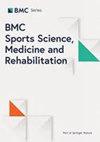成熟程度而非实际年龄对注意力控制的影响:对女性青少年运动损伤预防的启示
IF 2.1
3区 医学
Q1 REHABILITATION
引用次数: 0
摘要
非接触性损伤在年轻运动员中非常普遍,尤其是在需要快速决策和分散注意力的情况下。进行相关的神经认知测试有助于发现这些认知能力的缺陷,从而降低受伤风险。然而,选择性注意和反应抑制等过程可能在一定程度上取决于运动员的成熟阶段。我们旨在研究青少年排球运动员的成熟度对选择性视觉注意力和反应抑制的影响。在这项横断面研究中,52 名青少年女性(年龄为 12.3 ± 2.1 岁)进行了埃里克森侧手任务。采用 Khamis & Roche 方法,根据估计的成年身材将参与者分为几个亚组:青春期前(PRE;n = 13,年龄:9.9 ± 1.3)、青春期早期(EPUB;n = 7,年龄:10.5 ± 0.6)、青春期中期(MPUB;n = 8,年龄:12.6 ± 0.8)和青春期晚期(LPUB;n = 24,年龄:14.1 ± 0.9)。对一致和不一致的反应时间(RT)进行协方差分析(ANCOVA),并将相应的成功率(正确反应百分比)作为协变量。使用方差分析检验了侧翼干扰效应。还进一步检验了因变量与参与者年龄之间的相关性。在同义和非同义反应时间上,PRE 比 LPUB 的反应时间更长(P < 0.001)。在年龄和 RT 之间观察到中度负相关(Rp = -0.695,Rp = -0.614,分别针对一致和不一致的 RT),在年龄和不一致的成功率之间观察到低度正相关(Rs = 0.318)。在 LPUB 组中,RT(Rp = -0.431--0.532)和成功率(一致的负 Rs = -574,不一致的正 Rs = 0.417)也呈中低度相关。干扰效应与群体差异和年龄无关。我们的研究结果表明,女性青少年的信息处理能力和选择性视觉注意力在成熟晚期比成熟早期更强。但在反应抑制方面,不同成熟期的青少年并无差异。在实际年龄方面也观察到类似的趋势,但不能完全用实际年龄来解释。对于神经认知能力尚未完全发育成熟的青少年运动员来说,成熟度而非实际年龄应成为他们参与体育运动和预防受伤计划的指导。本文章由计算机程序翻译,如有差异,请以英文原文为准。
The impact of maturation level, not chronological age, on attentional control: implications for sports injury prevention in female adolescents
Non-contact injuries are highly prevalent among young athletes and occur particularly in situations that require fast decision making and divided attention. Administering relevant neurocognitive tests could help identify deficiencies in these cognitive abilities and thus potentially mitigate injury risk. However, processes such as selective attention and response inhibition might depend to some extent on the athlete’s maturation stage. We aimed to examine the effect of maturation on selective visual attention and response inhibition among adolescent volleyball players. In this cross-sectional study, 52 female adolescents (age 12.3 ± 2.1 years) performed an Eriksen Flankers task. Participants were divided into subgroups based on their estimated adult stature, using the Khamis & Roche method: Pre-pubertal (PRE; n = 13, age: 9.9 ± 1.3), early-puberty (EPUB; n = 7, age: 10.5 ± 0.6), mid-puberty (MPUB; n = 8, age: 12.6 ± 0.8) and late puberty (LPUB; n = 24, age: 14.1 ± 0.9). Analyses of covariance (ANCOVA) were performed on congruent and incongruent reaction times (RT), with corresponding success rates (% correct responses) as covariate. Flanker interference effect was tested using ANOVA. Correlations were further examined between the dependent variables and participants’ chronological age. There was a significant group effect, with PRE demonstrating longer RT compared with LPUB (P < 0.001) for both congruent and incongruent RT. Moderate negative correlations were observed between age and RT (Rp = -0.695, Rp = -0.614 for congruent and incongruent RT, respectively) and low positive correlations between age and incongruent success rate (Rs = 0.318). Low to moderate correlations were also observed within the LPUB group for RT (Rp = -0.431–-0.532) and success rate (negative Rs = -574 for congruent and positive Rs = 0.417 for incongruent). There were no group differences nor age associations with interference effect. Our findings indicate that information processing and selective visual attention are superior at late maturation compared with early maturation among female adolescents. The same cannot be said for response inhibition, which did not differ between maturation groups. Similar tendencies were observed with regards to chronological age, but not entirely explained by it. Maturation level, rather than chronological age, should guide practitioners during sport participation and injury prevention programs for young athletes, whose neurocognitive abilities are not yet fully developed, placing them at risk for non-contact injuries.
求助全文
通过发布文献求助,成功后即可免费获取论文全文。
去求助
来源期刊

BMC Sports Science Medicine and Rehabilitation
Medicine-Orthopedics and Sports Medicine
CiteScore
3.00
自引率
5.30%
发文量
196
审稿时长
26 weeks
期刊介绍:
BMC Sports Science, Medicine and Rehabilitation is an open access, peer reviewed journal that considers articles on all aspects of sports medicine and the exercise sciences, including rehabilitation, traumatology, cardiology, physiology, and nutrition.
 求助内容:
求助内容: 应助结果提醒方式:
应助结果提醒方式:


